The gleam of a freshly painted house is hard to beat. But achieving a professional level of the finish takes skill, patience, and the proper techniques.
When painting the exterior of a home, many DIYers and amateur painters simply grab a brush, roller, and some paint and get to work, but that rarely leads to a result worthy of the pros. To get the glossy, even coat and vivid colors that make a house a showstopper, it’s important to understand best practices.
From thorough preparation and priming to applying multiple finish coats, selecting high-quality supplies, and more, the details make all the difference. The ten tips in this guide will walk you through strategies the pros use to paint houses quickly and beautifully.

Prepare The Surface Thoroughly
Careful surface preparation is the key to a professional quality paint job. Clean the entire area to be painted and examine for any necessary repairs. Fill any cracks or holes with caulk or spackle and sand smooth. Remove loose paint and sand glossy areas to prepare the surface for new paint. Clean up dust with a tack cloth. Proper surface prep can take the most time but will yield the best results.
Choose The Right Paint
For most exterior surfaces, use quality latex paint with an acrylic base that is specifically intended for house paint. For trim, doors, and cabinets, choose a paint recommended for those surfaces. Get the highest quality paint you can afford for the most professional-looking durable finish. Buy all paint for a single project at once to avoid any minor color differences between batches.
Protect The Area And Have The Right Tools
Lay drop cloths and tape off any areas you do not want to paint. Use canvas drapes for large areas like plants. Have high-quality brushes for edges and trim in multiple sizes. Get premium roller covers in the recommended nap for the surface. Paint pans, paint pails, roller extension handles, trays, and paint strainers will also come in handy. Keep some rags, paint thinner, and cleaning products on hand in case of any drips or spills.
Apply A Primer For The Best Finish
For the best quality paint job that professionals provide, prime all bare or porous surfaces first. Primer helps the paint adhere better to the surface for a longer-lasting finish. It also creates an even base color to help topcoats appear truer and more uniform. On previously painted surfaces, spot prime any bare spots from damage or repairs before applying topcoats.
Choose Paint Colors Wisely
Choose complementary colors for trim, doors, lacquering cabinets and siding for the most cohesive look. Make color swatches to view options in natural light. Solid colors are simple while earthy tones complement wood styles. Accent doors and shutters in a contrasting color.
Brush First Then Roll
Professionals always brush trim, edges, corners, and any narrow areas first before rolling the larger, open areas. Brushing allows you to control the application and avoid drips and splatter. It also ensures an even coat on any intricate profiles. Use a quality tapered brush and take your time for a perfect finish. Only roll the broader, more open areas using longer, smoother roller strokes overlapping each pass.
Caulking And Sealing Windows And Doors
Apply caulk to seal any cracks around windows, doors, sills, foundations, and trims. The paint won’t adhere well to caulk, so let it dry first. Use caulk specifically meant for joints exposed to water and weather.
Also Read: Get Inspired by These 15 Black Front Door Ideas
Choose High-Sheen Or Flat Finish
A high-sheen paint reflects more light, brightening the house and making it glossy. Flat paints helps to absorb light for an ultra-matte look. Consider sheen based on the house style. Semigloss is versatile and works well on most homes.